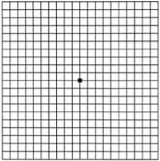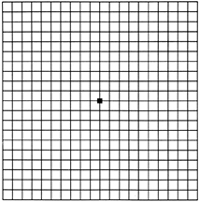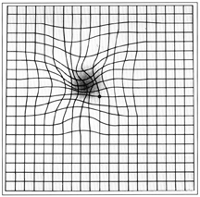
Amsler grid
Encyclopedia
The Amsler grid, used since 1945, is a grid of horizontal and vertical lines used to monitor a person's central visual field
. The grid was developed by Marc Amsler
, a Swiss ophthalmologist. It is a diagnostic tool that aids in the detection of visual disturbances caused by changes in the retina
, particularly the macula (e.g. macular degeneration
, Epiretinal membrane
), as well as the optic nerve and the visual pathway to the brain.

 In the test, the person looks with each eye
In the test, the person looks with each eye
separately at the small dot in the center of the grid. Patients with macular disease may see wavy lines or some lines may be missing.
Amsler grids are supplied by ophthalmologists, optometrists or from web sites, and may be used to test one's vision at home.
The original Amsler grid was black and white. A color version with a blue and yellow grid is more sensitive and can be used to test for a wide variety of visual pathway abnormalities, including those associated with the retina, the optic nerve
, and the pituitary gland
.
Visual field
The term visual field is sometimes used as a synonym to field of view, though they do not designate the same thing. The visual field is the "spatial array of visual sensations available to observation in introspectionist psychological experiments", while 'field of view' "refers to the physical...
. The grid was developed by Marc Amsler
Marc Amsler
Marc Amsler was a professor of ophthalmology at der Zurich Eye Clinic at the University of Zurich....
, a Swiss ophthalmologist. It is a diagnostic tool that aids in the detection of visual disturbances caused by changes in the retina
Retina
The vertebrate retina is a light-sensitive tissue lining the inner surface of the eye. The optics of the eye create an image of the visual world on the retina, which serves much the same function as the film in a camera. Light striking the retina initiates a cascade of chemical and electrical...
, particularly the macula (e.g. macular degeneration
Macular degeneration
Age-related macular degeneration is a medical condition which usually affects older adults and results in a loss of vision in the center of the visual field because of damage to the retina. It occurs in “dry” and “wet” forms. It is a major cause of blindness and visual impairment in older adults...
, Epiretinal membrane
Epiretinal membrane
Epiretinal membrane is a disease of the eye in response to changes in the vitreous humor or more rarely, diabetes. It is also called macular pucker. Sometimes, as a result of immune system response to protect the retina, cells converge in the macular area as the vitreous ages and pulls away in...
), as well as the optic nerve and the visual pathway to the brain.


Human eye
The human eye is an organ which reacts to light for several purposes. As a conscious sense organ, the eye allows vision. Rod and cone cells in the retina allow conscious light perception and vision including color differentiation and the perception of depth...
separately at the small dot in the center of the grid. Patients with macular disease may see wavy lines or some lines may be missing.
Amsler grids are supplied by ophthalmologists, optometrists or from web sites, and may be used to test one's vision at home.
The original Amsler grid was black and white. A color version with a blue and yellow grid is more sensitive and can be used to test for a wide variety of visual pathway abnormalities, including those associated with the retina, the optic nerve
Optic nerve
The optic nerve, also called cranial nerve 2, transmits visual information from the retina to the brain. Derived from the embryonic retinal ganglion cell, a diverticulum located in the diencephalon, the optic nerve doesn't regenerate after transection.-Anatomy:The optic nerve is the second of...
, and the pituitary gland
Pituitary gland
In vertebrate anatomy the pituitary gland, or hypophysis, is an endocrine gland about the size of a pea and weighing 0.5 g , in humans. It is a protrusion off the bottom of the hypothalamus at the base of the brain, and rests in a small, bony cavity covered by a dural fold...
.
See also
- ScotomaScotomaA scotoma is an area of partial alteration in one's field of vision consisting of a partially diminished or entirely degenerated visual acuity which is surrounded by a field of normal - or relatively well-preserved - vision.Every normal mammalian eye has a scotoma in its field of vision, usually...
- Epiretinal membraneEpiretinal membraneEpiretinal membrane is a disease of the eye in response to changes in the vitreous humor or more rarely, diabetes. It is also called macular pucker. Sometimes, as a result of immune system response to protect the retina, cells converge in the macular area as the vitreous ages and pulls away in...
- Macular degenerationMacular degenerationAge-related macular degeneration is a medical condition which usually affects older adults and results in a loss of vision in the center of the visual field because of damage to the retina. It occurs in “dry” and “wet” forms. It is a major cause of blindness and visual impairment in older adults...
- Preferential hyperacuity perimetryPreferential hyperacuity perimetryPreferential hyperacuity perimetry is a psychophysical test used to identify and quantify visual abnormalities such as metamorphopsia and scotoma.-Background:...
External links
- "Blind Spot Amsler Grid" Test from www.eyesight.org.
- Self-administered online eye tests Amsler grid, visual field mapping and Snellen eye chart

